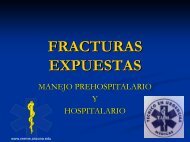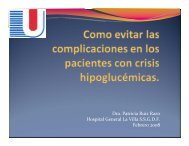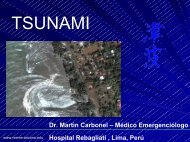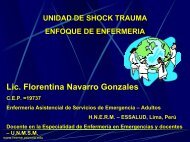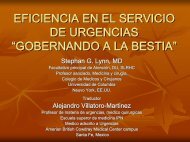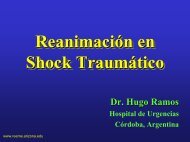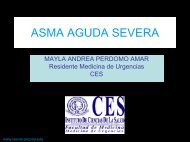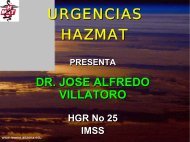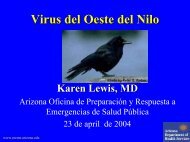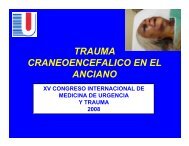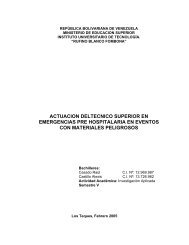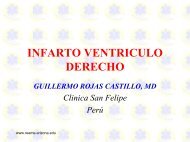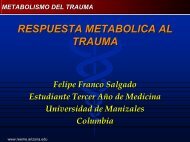Manejo del Paciente Politraumatizado - Reeme.arizona.edu
Manejo del Paciente Politraumatizado - Reeme.arizona.edu
Manejo del Paciente Politraumatizado - Reeme.arizona.edu
- No tags were found...
Create successful ePaper yourself
Turn your PDF publications into a flip-book with our unique Google optimized e-Paper software.
4. R<strong>edu</strong>cing the Risk of ATS LawsuitsFollowing the decision in Sosa, corporate boards of directors and officers should takeappropriate steps to r<strong>edu</strong>ce the risk of ATS lawsuits. The State Department and the UnitedNations provide some guidance to assist corporations in determining their obligations in thisarea. In 2001, the State Department published its Voluntary Principles on Security and HumanRights. These principles emphasize the importance of being “mindful of the highest applicableinternational standards.” They also provide numerous specific suggestions, offering advice onhow to assess the risk of certain areas, and stressing the need for careful interactions betweencompanies and public or private security forces.Similarly, the United Nations Global Compact is a corporate citizenship initiative thatsets forth several basic principles to which hundreds of private companies and other entities haveagreed. The principles are less concrete than the State Department’s Voluntary Principles butexhort companies to “make sure they are not complicit in human rights abuses.”It is, of course, obvious that a U.S. corporation with operations overseas cannot hire orassist a foreign government or government-sponsored group in killing, torturing or enslavinglocal citizens. However, the ATS may also create liability based on actions that are far moresubtle and difficult to uncover, such as indirect assistance to state actors through localcontractors. The suggestions below will assist a company in both detecting and avoiding thesepotential violations.a. Do your research. A corporation considering operations in a foreign nation musttake the time and absorb the expense to investigate that country thoroughly before deciding to dobusiness there. Even if it has already begun operations, a corporation should still determine whatrisks exist so it can better protect the corporation from harm.5
Historial <strong>del</strong> traumaVelocidadMuertes asociadas“rollover”ExtricaciónAltura de ser caídaCon que fue el choque: peor con objeto fijoy animalesCon o sin cinturón, con o sin “airbag”www.reeme.<strong>arizona</strong>.<strong>edu</strong>
Historial <strong>del</strong> accidenteAccidente de autoTipo de colisión: lateral, frontal, posterior, nosindica los posibles mecanismos <strong>del</strong> traumaCriterios de manejo en centro de traumaExpulsión <strong>del</strong> autoMuerto en el mismo compartimientoMas de 40mphDeformidad <strong>del</strong> auto de mas de 20’’Intrusión en la cabina de mas de 12’’Extricación de mas de 20minMotora a mas de 20mphSeparación de motora-motociclistaPeatón arrollado a mas de 5mphCaída mas de 20 pieswww.reeme.<strong>arizona</strong>.<strong>edu</strong>
<strong>Manejo</strong> en Sala de EmergenciasTriage categoria roja<strong>Manejo</strong> en equipoDiagnóstico y manejo simultáneoSignos vitales 5:Presión, pulso, oximetria, temperatura,respiracioneswww.reeme.<strong>arizona</strong>.<strong>edu</strong>
<strong>Manejo</strong> en Sala de EmergenciasEvaluación PrimariaABC’SAirway- vía aéreaSiempre sospechar daño alárea CervicalInmovilización CervicaltempranaVía aérea: evaluar,proteger, limpiar:”Jawtrust,chin lift”(si no haydaño cervical), Succión,intubación orotraqueal(alineada) , quirúrgicawww.reeme.<strong>arizona</strong>.<strong>edu</strong>
<strong>Manejo</strong> en Sala de EmergenciasBreathing-RespiracionesEvaluación:Presencia derespiración espontáneaRazón respiratoria 29min- fallorespiratorio. Po2,60mmhgCianosis, oximetria,severidad <strong>del</strong> “shock”flail chest (pecho enbamboleo) –dos o mascostillas rotas en doslugares diferenteswww.reeme.<strong>arizona</strong>.<strong>edu</strong>
<strong>Manejo</strong> en sala de EmergenciasBreathing-Mov. . paradójico <strong>del</strong>segmento afectadoMatidez a lapercusión,Ø sonidosrespiratorios,pérdida de volumensanguineoHerida abierta en elpechoTráquea desviada,no sonidosrespiratorios,distención jugularvenosa, cianosisFlail chestHemotóraxmasivoPneumotóraxabiertoPneumotóraxatensiónIntubación n y MVIFV’s, , resucitaciónde fluidos, tubo depechoBendaje a presión,tubo de pechoDecomprensión n poraguja, tubo depechowww.reeme.<strong>arizona</strong>.<strong>edu</strong>
<strong>Manejo</strong> en sala de EmergenciasRecuerden que:Menores de 8 añosno “cuff”.Tamaño como lacircunferencia <strong>del</strong>meñiqueMenores de 12 añoscricotiroidotomia deagujaLuego de laintubación: CXR,ABG, 100% oxígenowww.reeme.<strong>arizona</strong>.<strong>edu</strong>
<strong>Manejo</strong> en sala de EmergenciasIntubación .Como saber si esta bienintubado???Visualización directa <strong>del</strong>as cuerdas, capnografia,aumento en saturación,auscultaciónAuscultar barriga 1ro!!Pneumotórax izquierdoRetraer tubo para reexpansiónRepetir cxr!!!,ABG’swww.reeme.<strong>arizona</strong>.<strong>edu</strong>
<strong>Manejo</strong> en sala de EmergenciasCirculaciónCirculación y controlde hemorragia2 líneas antecubitalescon angio 16 y IVFtibiosEvaluación:1.pulso central yperiferal2.razón cardiaca3.presión4.llenado capilar(
<strong>Manejo</strong> en sala de EmergenciasCIRCULATIONCardiacarrestMassiveexternalbleedingInternalbleedingCardiacTamponadeCPRDirectPressure2x i.v. linesFluidresuscitation2x i.v. linesFluidresuscitationPericardiocentesisi.v. lineFluidresuscitationwww.reeme.<strong>arizona</strong>.<strong>edu</strong>
<strong>Manejo</strong> en sala de emergencias:evaluacion primaria cont.DisabilityEvaluaciónneurológica:- nivel de consciencia- escala AVPU, GCS- Pupilas: tamaño,reactividad, simetría-Explorar si haysignos de localizaciónwww.reeme.<strong>arizona</strong>.<strong>edu</strong>
Evaluacion primariaExposure (quitar la ropa <strong>del</strong> paciente)No se puede completar la evaluaciónprimaria sin examinar toda lasuperficie <strong>del</strong> cuerpo <strong>del</strong> paciente paradescartar laceraciones, cuerposextraños, fracturas abiertas,hematomasAl completar el examen debe arroparseal paciente para prevenir hipotermiawww.reeme.<strong>arizona</strong>.<strong>edu</strong>
<strong>Manejo</strong> <strong>del</strong> pacienteEKGHR/BPoximetriaCapnografiaOutput urinarioTemperaturaEstatus mentalLaboratoriosTipo y grupoCBCABG, acido lacticoelectrolitosDXTPruebas deCoagulaciónALT, AST, CKBUN, creatininawww.reeme.<strong>arizona</strong>.<strong>edu</strong>
<strong>Manejo</strong> <strong>del</strong> pacienteIVF 2 lineasPlacas“trauma series”CXR, CS, PelvisHCT si pérdida deconocimiento ocambiosneurológicosExamenRectal (antes <strong>del</strong>foley)PélvicoTubos en todoslos orificiosNGTFoleywww.reeme.<strong>arizona</strong>.<strong>edu</strong>
<strong>Manejo</strong> <strong>del</strong> pacienteCuándo no se poneun foley???Hematoma deescrotoSangre por la uretraPróstata alta enexamen rectalSIEMPRE SE HACERECTAL PRIMEROCuando no se poneun NGT???Trauma evidente a lacaraSe coloca orogástricowww.reeme.<strong>arizona</strong>.<strong>edu</strong>
<strong>Manejo</strong> <strong>del</strong> pacienteSiempre recordar:Antitetánica Td .5ccIMAntibióticosAncef 1G IVGaramycin 80mg de haber fracturasabiertaswww.reeme.<strong>arizona</strong>.<strong>edu</strong>
Evaluación SecundariaExamen de cabeza a piesTrauma a cabezaTrauma espinalTrauma al tóraxTrauma pélvico y deextremidadesTrauma abdominalwww.reeme.<strong>arizona</strong>.<strong>edu</strong>
Trauma a cabezaHCT - GCSContusionEpiduralSubduralSAHSkull seriesFracturasDeprimidalinealwww.reeme.<strong>arizona</strong>.<strong>edu</strong>
Trauma espinalInmobilizacióncervical tempranaLocalizar el nivel dedañoSolumedrol30mg/kg en 1hora5.4mg/kg/hr por 23horasPlacas AP, lat,odontoideDebe verse de C1-T1www.reeme.<strong>arizona</strong>.<strong>edu</strong>
Trauma al tóraxVerificar placa depechoPneumotóraxHemotóraxMediastinoVerificar enfisemasubcutáneoMovimiento de lacavidad toráxicaPatrón respiratorio ycalidad de lossonidosrespiratorioswww.reeme.<strong>arizona</strong>.<strong>edu</strong>
Trauma pélvico y de extremidadesEvaluar color, pulso,deformidad, llenadocapilarPrueba de embarazoy examen pélvicoFractura de pelvis-Fijador externosábana.Pérdida dehasta 3 litros desangreInspeccionargenitalia masculinaantes <strong>del</strong> foleySangre por uretra,hematoma de escrotoy próstata alta -NOwww.reeme.<strong>arizona</strong>.<strong>edu</strong>
Trauma abdominalÓrganos masafectadosBazo-trauma romoHígado- penetranteDolor abdominalluego de trauma enRUQ, LUQSonogramaCT abdominalDescartarlo en todopaciente con estadomental alteradowww.reeme.<strong>arizona</strong>.<strong>edu</strong>
Que vamos a hacer????Que está mal????? A- inmovilizar cuello,limpiar vía aérea,succionar- intubación sino está patenteB – intubación, tubo depechoC- 2 líneasantecubitales angio 14-16D- pupilas GCS AVPUE- remover ropa yarropar para prevenirhipotermiaRectal –foley,OROGASTRICOCBC – T+G, T+CCXR, CS, Pelvis, HCTAntibiótico y toxoidewww.reeme.<strong>arizona</strong>.<strong>edu</strong>Transferir a centro detrauma
ConclusionesEl éxito <strong>del</strong> buen manejo <strong>del</strong> pacientepolitraumatizado esta en el trabajo enequipo.Sospechar trauma cervical en todomomentoSeguir los ABC’s<strong>Manejo</strong> y tratamiento sistemáticoEvaluación primaria y secundariaTransferencia a centro de traumawww.reeme.<strong>arizona</strong>.<strong>edu</strong>



